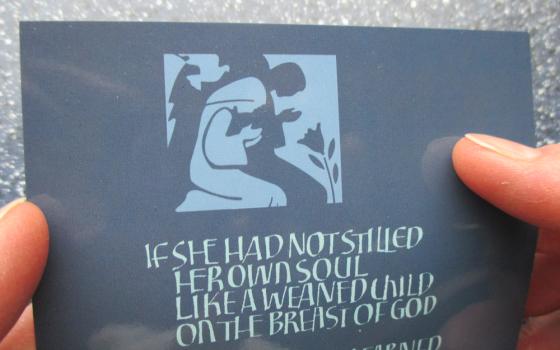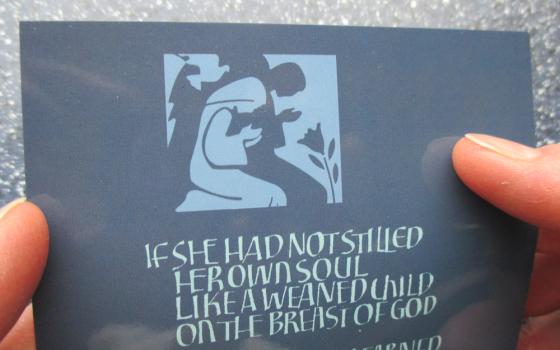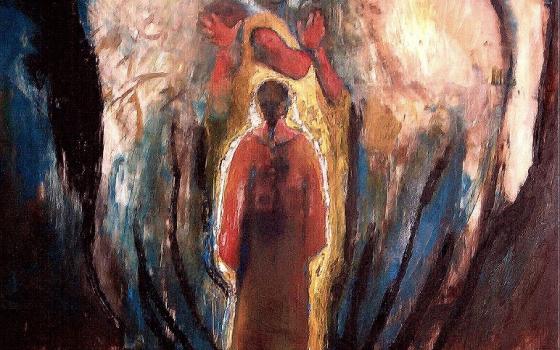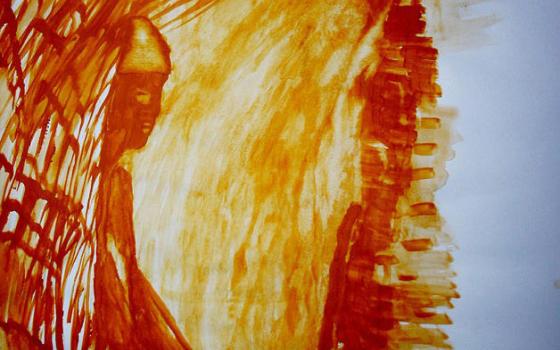IF
she had not stilled her own soul
like a weaned child
on the breast of God
IF
she had not learned
to touch presence
in emptiness
IF
she had not attuned her inner ear
to the heartbeat of God
or the whir of wings
Would she have even noticed the angel?
[Poem by the author]
This poem is perfectly illustrated by this artwork by an unknown artist (discovered by a monk at Caldey Abbey in Wales).
What seems to be the shadow of Mary could also be the angel, both of them kneeling in prayer. In the shadow of the angel’s wing is a dove, a wing within the wing, a whisper of the Holy Spirit’s presence. Which is the positive and which is the negative? Which the presence and which the emptiness? Is it not Mary’s emptiness that attracts the Holy Spirit to fill her with the presence of the Word? “Let it be done to me according to your word.” Mary hears the word of God with her ears, and conceives Jesus in her flesh.
Another interpretation of the Annunciation was painted by Daniel Bonnell.
The angel’s wings look like a pair of huge ears, as if to say: "Listen! God's word is here." It is all about hearing and doing the word of God.
What do wings sound like? What is the sound of one wing clapping? The angel holds its hands in a way that reminds me of the laying on of hands at an ordination. Mary is to be ordained to bear the High Priest Jesus. Where was she going when the angel appeared? It looks to me as if she had just been doing the daily routine, had just got up out of bed and was going through the door to pray when she heard a whoosh! And these gigantic, feathery ears appeared with a surprising message. ...
A little research on feathers reveals that the scientific class for birds is "Aves." As in avian, aviary, aviation. What did the angel say? Ave Maria! One of the functions of feathers is to capture air so the feathers insulate the bird — or the person in Norway who uses a down quilt. The eider ducks on Tautra (an island in the Trondheim Fjord, site of both the new Mariakloster monastery and an ancient Cistercian monastery) were famous for the quality of their down, and I’ll bet there was more than one medieval monk who had a down pillow. The small pockets of air in down feathers capture emptiness — which together with the living creature, create a warm presence.
March 25, the Solemnity of the Annunciation, is the foundation day of both the 1999 Mariakloster and the 1207 monastery on Tautra.
Henry Ossawa Tanner, widely considered to be the first African-American artist to be recognized internationally, painted "The Annunciation." The angel’s presence is portrayed by light. Was Mary awakened at night? Or was it as if the sunrise were coming into her room? Did she see the light or did she feel the presence? In our monastic community we talk about the quality of our presence to one another. What does presence feel like? Was the presence of the angel comforting, or was it frightening? When we encounter one another, are we empty enough of our own ego that our presence is comforting? Or are we filled with ourselves and our own agendas, or driven by a powerful emotion, so that our presence is perhaps more frightening?
On one of my visits to my parents in Los Angeles, I went to the J. Paul Getty Museum, where there was an exhibit on the use of blank space in paintings. What is the color of light? We know that white light contains all the colors. It is only when light is split, as by a prism or by the drops of water that result in a rainbow, that we get colors. Each drop of water acts as a prism to split the sunlight so we see the spectrum from red through violet. So, white light is a fullness of presence. Color is actually the absence of some of the other wavelengths.
If you were an artist, how would you paint light? In that exhibit, the most common way was to leave the part that was to be light, blank — so the white canvas showed through. The complete light was the emptiest space. The most intense presence was where human activity was most absent.
This very modern Annunciation painting is by Gloria Ssali, a Ugandan artist working in the U.K.
At first I thought the angel was on the left, because of the pattern that looks like feathers. There is something that looks like a hand, as if ushering the Word into Mary’s womb. Then I thought the angel was the figure on the right, approaching Mary and overshadowing her with its wings. The angel’s mouth seems to be open: in greeting, or breathing the Word that Mary hears and conceives. And there seems to be light and fire coming out of it. Maybe it’s meant to be ambiguous. It takes two to tango. Our Lady and the Holy Spirit. What shall this be? May I have this dance?
When I was a junior professed and had a class on the history of the order, I remember lamenting the fact that so few Cistercian women have left a record of their life experience, their thoughts, their dreams or their insights into God. We thought it was because men, for some reason, are more driven to record what they experience, while women are too busy living it to take the time to write it down. Is it the same with the Annunciation?
Let us be the women who attune our inner ear to the heartbeat of God, who listen for the whir of wings on the way to prayers, who find presence in the most empty spaces, who dance to bring the Holy to birth. “Tautra Mariakloster” can be translated as the Monastery of Our Lady of the safe island, or Our Lady of the safe harbor. On this 18th anniversary of the founding of our monastery, it could be translated as Our Lady of the safe womb, and Our Lady of the safe enclosed space.
[Sr. Sheryl Frances Chen was assistant editor of U.S. Catholic magazine before she entered the monastery to join the Order of Cistercians of the Strict Observance (OCSO). Now she is chantress and Saturday cook at Tautra Mariakloster on an island in the Trondheim fjord.]




